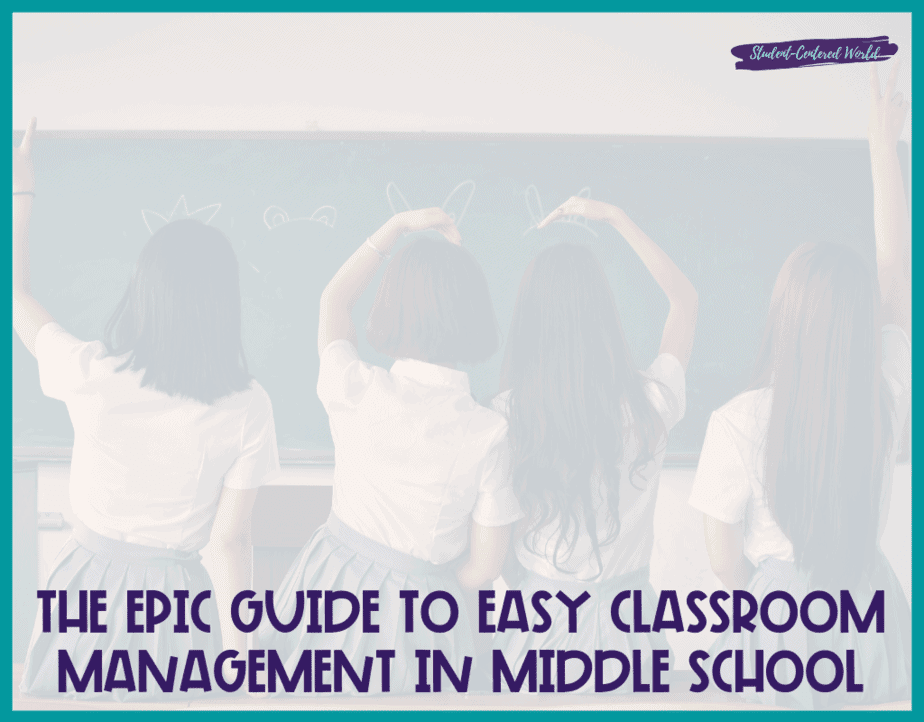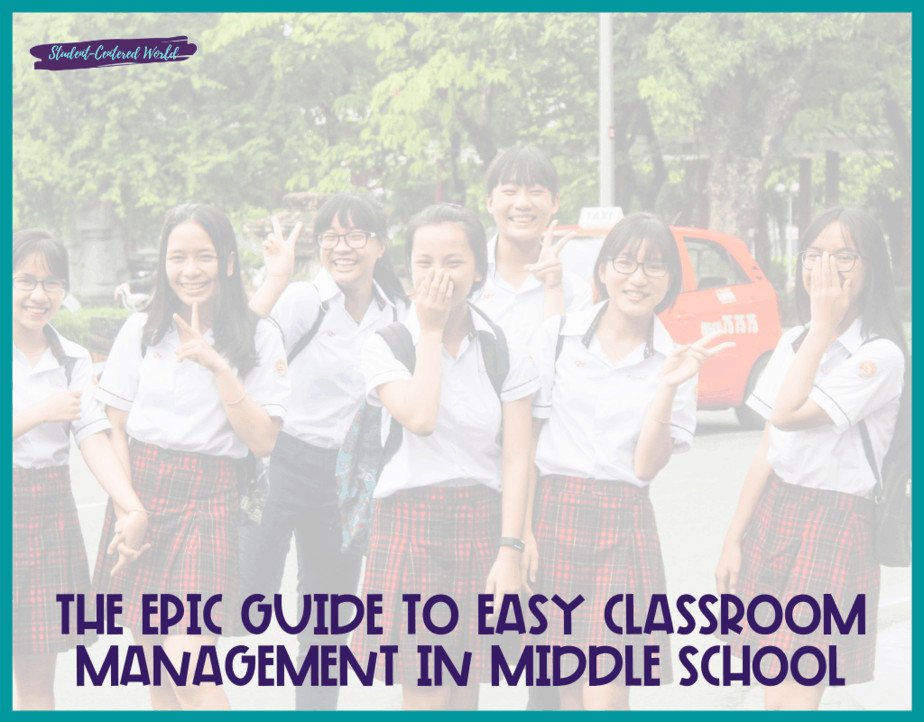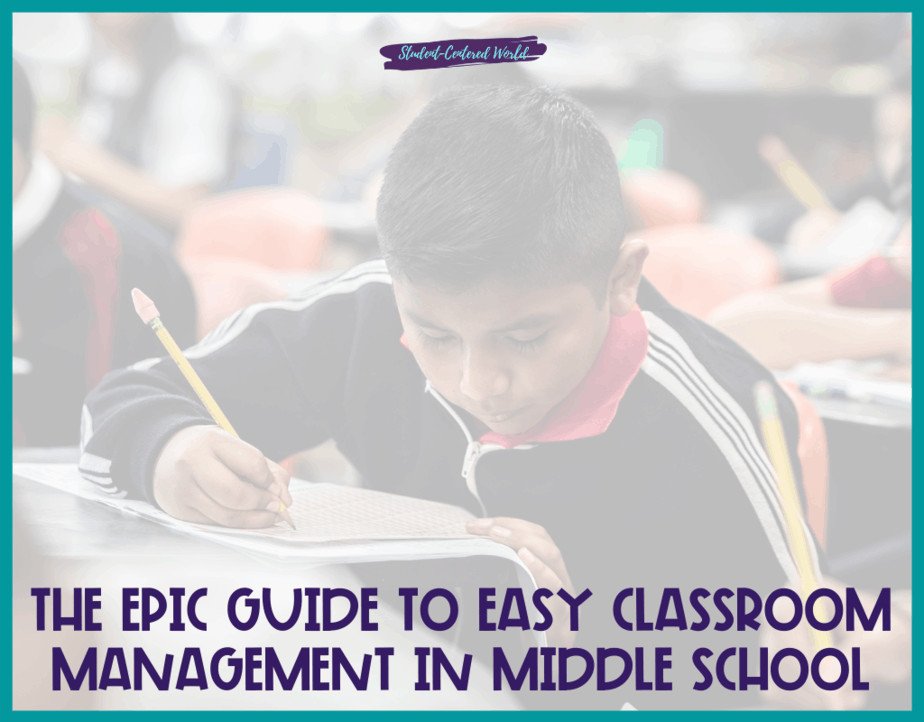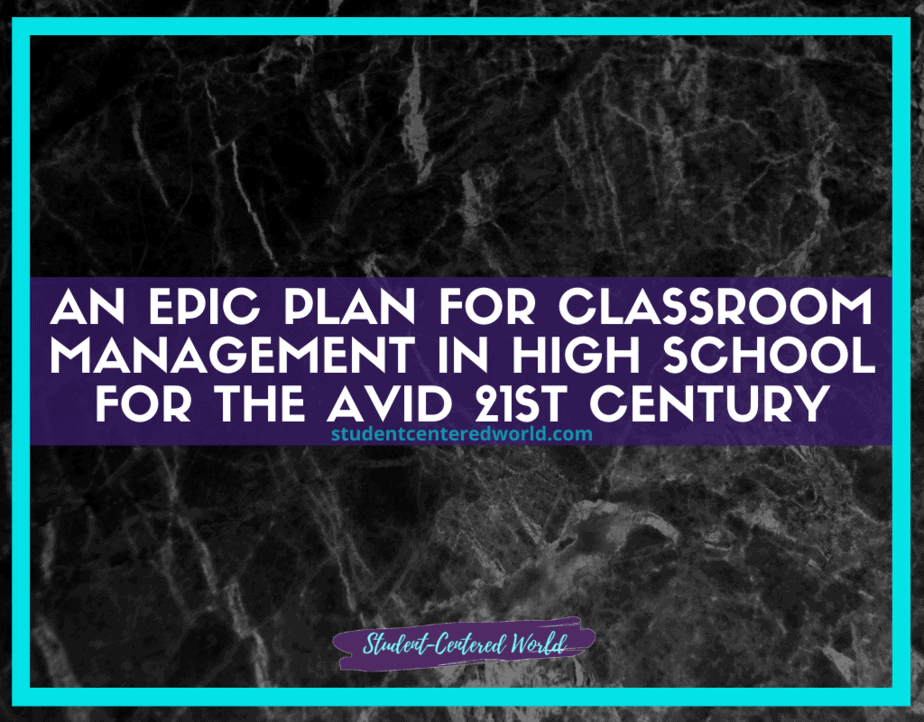The Epic Guide to Easy Classroom Management in Middle School (4th-8th)
It’s no secret that middle school is a trying age group to teach and is certainly not for the faint of heart. Classroom management in middle school can be a challenge, but by considering engagement techniques, brain breaks, and processes and procedures dealing with discipline and behavior expectations, it can easily become a well-oiled machine.
Middle school aged students can be challenging for a number of reasons. They have an independent streak and are known to question rules, test the boundaries of authority, and inquire about the reasons behind every “why.” Furthermore, they can be impulsive and easily distracted by one another or their own thoughts.
It’s not all negative, though. Our junior high kids can also be empathetic, forgiving, and helpful. They still have the wonder of a child in many cases and, if their peers are buying into a classroom procedure, they will, too.
Needless to say, classroom management in middle school is a high-stakes business. The students are still quite impressionable and easily influenced by their peers. The teacher wields a tremendous amount of influence over the group. What we say and how we interact with our students has a huge impact on who they will become as adolescents and, in turn, as adults.
How, then, do we manage this age group? What is effective classroom management? How do our students learn best and how can we harness that energy to teach them effectively in the middle grades? All of these factors considered, classroom management in middle school is a necessity. Students must know how to conduct themselves appropriately, follow directions, and work in groups. They must also be taught the expectation of respect, both for their peers and authority figures. It’s a tall order for sure!
We have all heard advice on behavior management strategies throughout our careers. The first piece to consider overall in deciphering classroom management in middle school is the classroom environment.

The Classroom Environment (the most important piece of classroom management in middle school)
The classroom environment is an extension of the classroom management plan. The classroom environment should be a physical representation of what you are trying to accomplish within your classroom management plan. This includes, but in no way limited to, classroom rules posted throughout your classroom and/or hallway(s); classroom door open or closed (if closed, why and how long); classroom quiet and engaged time; classroom cleanliness; classroom appearance inside and out (including an inviting classroom, a classroom with a variety of supplies available to the students, and a classroom that is organized); student seating arrangements which are consistent and allow for maximum coverage; the list could go on and on.
Remember that your classroom environment is a direct reflection of you (your philosophy), your classroom management strategies, and the way that you manage students in your classroom. Think about whether or not your current environment is helping to create the type of culture in which you intend for your classroom to be run. Is it a positive environment? What elements need to be changed? Is it conducive for efficient management and a great learning environment? Is it inviting?
These are all questions to ask yourself with regards to your classroom environment. If you feel that the environment is not conducive to optimal student engagement and learning, then act upon it!
Now that we have an idea of the type of atmosphere that we want our classrooms to be, let’s consider the classroom management in middle school strategies that we will use to maintain a positive classroom environment and teach our students responsibility.
Student Responsibility in Classroom Management in Middle School
Many teachers like to explain their classroom rules by saying something similar to, “This is what we do in this class. And these are the consequences if you don’t follow them.” When I hear this stated repeatedly, I cringe a bit. I see the way that it is stated and I try to understand why teachers do this. The word “consequence” has a negative connotation, and we are trying to avoid negativity in the classroom.
When you tell students what will happen if they don’t follow the rules, you are making a direct threat: “If you don’t do what I say, then this will happen”. Telling students what you are going to do next in the classroom developmentally stunts their learning and growth. It is not an effective way to communicate with middle school students. Students can easily shut down when they hear us use these words.

We want to be very specific in the rules that we set in our classrooms. We want to be clear about which behaviors will elicit consequences and also specific about what those consequences are. I believe that you can convey expectations without having to use “consequences” as a part of your vocabulary with students. If you find yourself using “consequences” often, stop and evaluate the way you communicate with students.
Instead of saying “If you don’t follow directions, then I will give you a warning”, try this: “If you don’t follow my directions (rules), then I am going to take away your choice board privileges”. Instead of telling students what we are going to do next as teachers, it is better to explain to students what they are supposed to be doing during specific times in the classroom.
When explaining your class rules and expectations, avoid using “consequences” altogether. For example: “If you follow my directions (rules) I will give you a choice board reward. If you do not follow my directions (rules) then I am going to take away your choice board privileges”. In both of these examples, the second example is more effective. Students know exactly what it takes to earn a reward/consequence from us.
Now that we have an understanding of why communicating with students in this way is important, let’s discuss how we can practice this type of classroom management in middle school.
Practicing Classroom Management in Middle School
There are many tools that you can use to get students to follow your directions (rules). We will discuss a few of these strategies below:
The choice board strategy is very effective for communicating with middle school students. It gives them the opportunity to earn a reward in various ways. It is also a great way to teach students responsibility because they are responsible for making good choices and following rules. A classroom management choice board is basically “reward time”.
You create the board ahead of time with tasks written on post-it notes, along with the corresponding rewards for each task. You post the board in a very visible location in your classroom so that students can see what choices they have to earn a reward. During choice board time, you give students choices between various tasks. They complete the task/complete their work correctly and then trade the post-it note for a reward.
For example: “If I have the best doodling of the day, then I can earn 2 extra minutes on my free reading time. If I demonstrate good listening skills, then I can earn 15 extra minutes of free time. If I clean up my desk at the end of class every day, then I can earn an additional 10 minutes for my choice board”.

The classroom management in middle school choice board strategy is not only an effective way to communicate with students during the school day, but it is also a great behavior incentive for students. If they are working hard to earn their rewards/consequences, then you have effectively communicated to them that they have some control over their learning environment.
You can also use “choice boards” to remind students of the consequences for not following your rules/directions. If you notice that a student is struggling with behavior, then it may be time to post an appropriate consequence choice board in order to show them what they can earn if they follow your directions.
An example: “If I keep my hands to myself, then I can earn 5 extra minutes of free time. If I do not keep my hands to myself, then I will lose my choice board privileges for the day.
In a classroom full of middle schoolers, it is important to realize that they are coming from all different backgrounds, experiences, and upbringings. One child might have been extremely well behaved while another could be the complete opposite. Some kids may have had a teacher for each grade or every other grade until middle school, while others may have had just a handful of teachers for their entire education. Some kids are in an environment where they are learning responsibility and independence while others may be used to being able to act out without much consequence.
This is important because classroom management in middle school is different than teaching the classroom.
At the middle school level, students are just beginning to find their identities and may take pride in being rebellious or finding ways to cause chaos. In many cases, they are right on the verge of learning self-control and that is where you come in. Instructors need to be the example of the positive behavior that is expected in the class. It is not good enough to just instruct and point out the negative behavior.
The key to effective instruction, in this case, is classroom management in middle school.
Although there are many different techniques to choose from, some of the most successful ones rely on asking students questions and holding them accountable for their answers. They also require a great deal of movement around the room. The reasoning behind that is simple. When you sit at your desk, all eyes will be shooting toward you in order to see what you are going to do next. This is contrary to what we want them to do because they should be paying attention to the lesson rather than wondering what you will do next.
Stop Driving the Teacher Struggle Bus
Are you struggling with student engagement, apathy, or keeping your class on track?
💫💫 There’s hope! 💫💫
Join my free teacher workshop “Choosing Choice” and in just 60 minutes, you’ll craft a practical plan to revitalize your teaching. Discover the magic of student choice in boosting engagement, gain quick implementation ideas, and explore strategies for year-long success.
Unlike overwhelming workshops, my approach guides you in real-time, providing more classroom options, reducing stress, and giving you more personal time.
Plus, you’ll earn a 1-hour professional development certificate and have 7 days of access.
Don’t miss this chance to transform your teaching; click below to secure your spot now!






